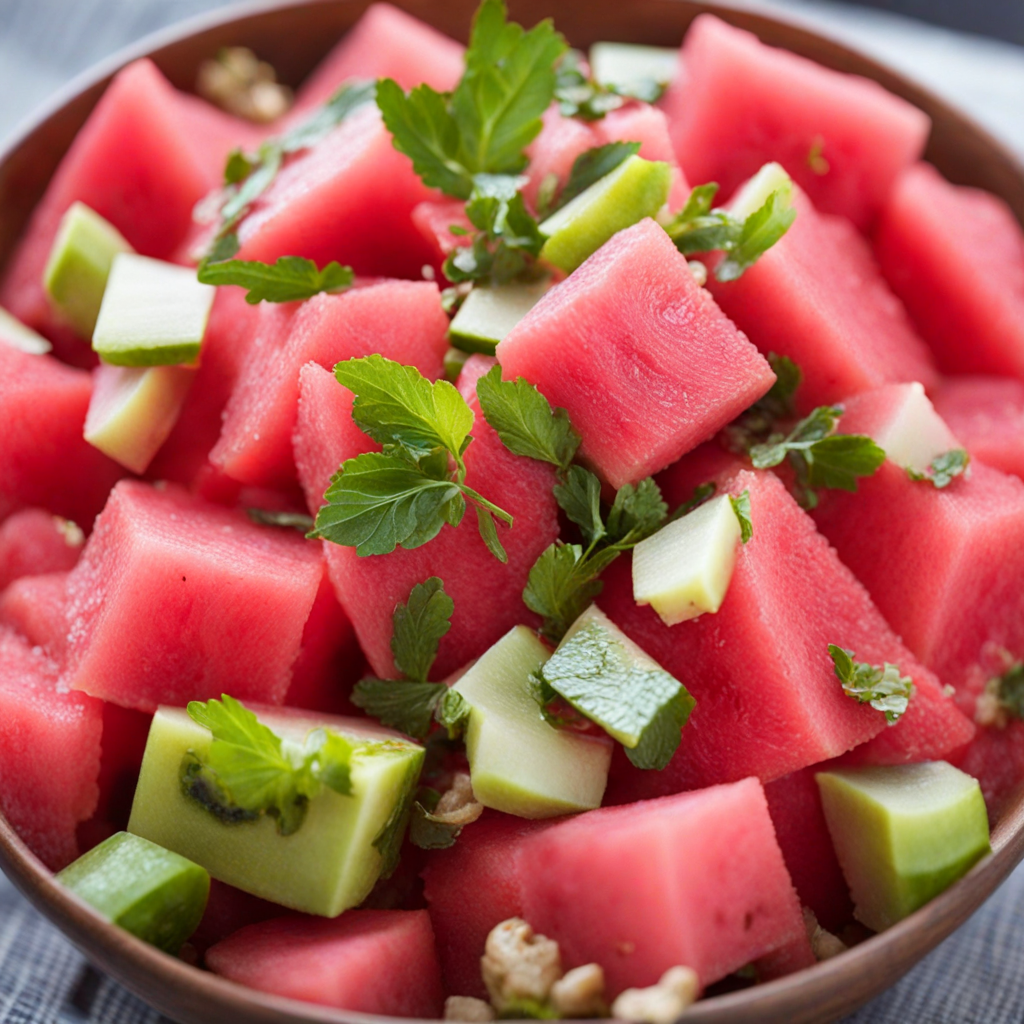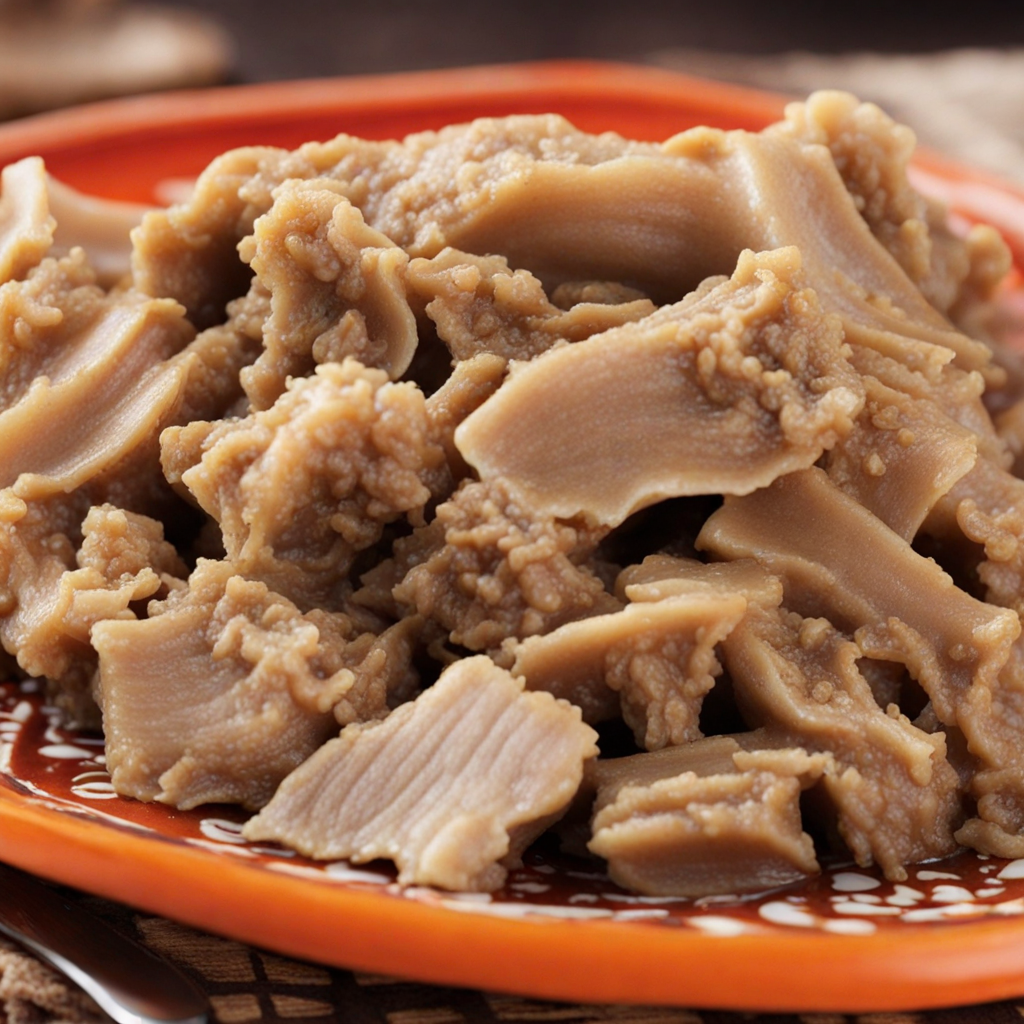Watermelon Salad
Watermelon Salad from Botswana is a vibrant and refreshing dish that embodies the essence of summer and the natural sweetness of its key ingredient. The salad typically features juicy, ripe watermelon, which is diced into bite-sized pieces, creating a delightful contrast of textures. The bright pink flesh of the watermelon is not only visually appealing but also provides a hydrating base, making it perfect for warm weather. The natural sweetness of the watermelon is often complemented by the addition of fresh herbs, such as mint or basil, which add a fragrant element and enhance the overall flavor profile. To elevate the salad further, traditional ingredients like crumbled feta cheese or goat cheese are sometimes included, introducing a creamy, tangy element that balances the sweetness of the watermelon. Additionally, a drizzle of balsamic vinegar or a squeeze of lime juice can bring a zesty brightness to the dish, cutting through the richness of the cheese and enhancing the overall taste experience. Nuts, such as toasted almonds or walnuts, can also be sprinkled on top, providing a satisfying crunch and nutty flavor that rounds out the dish. This Watermelon Salad is not only a feast for the senses but also a celebration of freshness and simplicity. It is often served as a side dish during gatherings or as a light meal on its own, showcasing the vibrant culinary culture of Botswana. Enjoying this salad is like taking a bite of summer, where each forkful bursts with juicy sweetness, aromatic herbs, and satisfying textures, inviting you to discover the essence of Botswana's unique flavors.
How It Became This Dish
Salate ya Legapu: A Culinary Journey Through Botswana #### Origins and Ingredients Salate ya Legapu, often simply referred to as legapu salad, is a traditional dish originating from Botswana, a landlocked country in Southern Africa known for its rich cultural heritage and diverse culinary practices. The name "legapu" translates to "sorrel" in English, which is a key ingredient in this refreshing salad. Sorrel (Rumex acetosa) is a leafy green plant that thrives in the cooler regions of the country, particularly during the rainy season. Its tart flavor brings a unique zest to the dish, making it a favored choice among locals. The origins of Salate ya Legapu can be traced back to the traditional diets of the Batswana people, who have long relied on indigenous plants and locally sourced ingredients. The use of sorrel in this salad speaks to the resourcefulness of the Batswana, who have historically foraged for wild greens and herbs to supplement their diets, especially during the harsher months when staple crops may be scarce. #### Cultural Significance Salate ya Legapu is more than just a dish; it embodies the essence of Botswana's food culture. In a country where communal dining and family gatherings are vital social practices, this salad often appears on the table during special occasions, celebrations, and everyday meals alike. It is typically served alongside traditional dishes such as pap (a porridge made from maize meal) and various meat stews, showcasing the balance of flavors and textures that characterize Botswana's culinary landscape. The preparation of Salate ya Legapu is often a communal affair. Family members come together to wash, chop, and mix the ingredients, fostering a sense of unity and cooperation. This aspect of food preparation reinforces the importance of community in Botswana, where meals are often shared among family and friends. Moreover, Salate ya Legapu holds a special place in the hearts of many Batswana, as it encapsulates the connection between food and identity. For the Batswana, traditional foods are a source of pride, representing their heritage and the wisdom of their ancestors. The use of sorrel, a plant that has been cultivated and consumed for generations, symbolizes the continuity of cultural practices and the deep bond between the people and their land. #### Development Over Time As Botswana has modernized, so too has its food culture, including Salate ya Legapu. In the past, the salad was primarily made with fresh sorrel, tomatoes, and onions, seasoned with a simple dressing of salt and vinegar or lemon juice. However, with globalization and the influx of new culinary influences, the salad has evolved to incorporate a variety of ingredients and flavors. Today, it is not uncommon to find Salate ya Legapu adorned with additional elements such as bell peppers, cucumbers, and even avocado, reflecting a more contemporary approach to cooking. Some variations include the use of nuts or seeds for added texture and nutritional value, while others might incorporate cheese or yogurt for creaminess. These adaptations highlight the versatility of the dish and the willingness of modern cooks to experiment while still honoring traditional roots. The rise of health consciousness among consumers has also influenced the preparation and presentation of Salate ya Legapu. With increasing awareness of the benefits of consuming fresh vegetables and herbs, the salad has gained popularity not just within Botswana but also among health enthusiasts in neighboring countries. This has led to a growing interest in sustainable farming practices and the promotion of indigenous crops, including sorrel, which is rich in vitamins and minerals. In urban areas, particularly in Gaborone, the capital city, Salate ya Legapu can be found in restaurants and cafés that aim to provide a taste of traditional cuisine with a modern twist. Chefs are now experimenting with presentation, serving the salad in stylish ways that appeal to both local and international palates. This evolution not only ensures the survival of traditional dishes but also fosters a greater appreciation for Botswana's culinary heritage on a global scale. #### Salate ya Legapu Today In contemporary Botswana, Salate ya Legapu is more than just a salad; it serves as a symbol of resilience and adaptability. As the country continues to navigate the complexities of globalization, issues related to food security, and the preservation of cultural identity, Salate ya Legapu stands as a testament to the enduring nature of traditional foods. The salad is often featured in food festivals, cultural events, and culinary competitions, where it is celebrated as a quintessential dish of Botswana. These events provide a platform for chefs and home cooks alike to showcase their interpretations of the salad, encouraging creativity while preserving its foundational elements. Furthermore, the increasing interest in indigenous crops and the push towards sustainable eating practices have brought renewed attention to Salate ya Legapu. Organizations and local farmers are working together to promote the cultivation of sorrel and other native plants, thus ensuring that future generations can continue to enjoy and celebrate this remarkable salad. #### Conclusion Salate ya Legapu is more than just a simple dish; it is a reflection of Botswana's rich cultural tapestry and a symbol of the connection between the people, their land, and their culinary traditions. As it continues to evolve and adapt to modern tastes while remaining rooted in its origins, Salate ya Legapu serves as a reminder of the importance of food in shaping identity, fostering community, and preserving the stories of a nation. Through its journey from a traditional salad to a contemporary favorite, Salate ya Legapu stands as a delicious testament to the resilience and vibrancy of Botswana's culinary heritage.
You may like
Discover local flavors from Botswana







